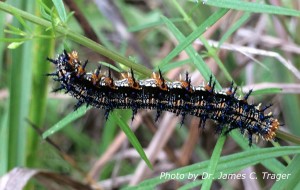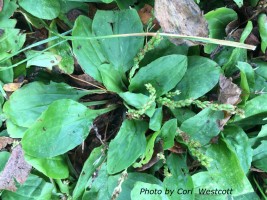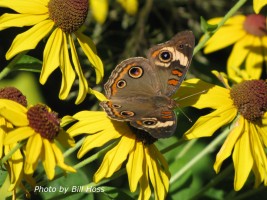By Cori Westcott of Bring Conservation Home
While enjoying the expansive vista of a prairie, my eye stopped upon a strange looking little creature just beyond the boardwalk. A buckeye (Junonia coenia) caterpillar was dining upon a slender-leaved false foxglove (Agalinus tenuifolia), formerly a Gerardia.
The false foxglove flowers from August to October and was in the middle of its flowering time. Its pink, tubular-shaped bloom has five petals. Like its name, the leaves are indeed very slender.
If you want buckeyes in your garden, don’t be discouraged if you can’t find a vendor who sells false foxglove. The buckeye is a generalist insect and thus, feasts on a number of plants.
If you are not treating your lawn with herbicides, you may already have one of the buckeye’s favorite host plants, common plantain (Plantago major) or its cousin narrowleaf plantain (Plantago lanceolata), which are generally considered weeds. The stalks hold thousands of seeds and interrupt the grass in a lawn. Toadflax (Linaria) and snapdragon (Antirrhinum) are also favored foods.
Plantain likes to establish in disturbed soil, such as along roads. Not only is plantain good for the buckeye caterpillar, it contains calcium and vitamins A and C and can be eaten by humans. Folks look for the young, tender leaves for addition to their salads.
The buckeye butterfly is an acrobatic daredevil compared to the leisurely up-and-down flutter pattern of the monarch. The male often settles close to the ground, waiting for a female, but will give chase to anyone flying overhead! On top of being aggressive, they appear skittish, when in reality, they might simply be moving faster than other butterflies. That illusion might be due to their extraordinary aerial skills.
The beautiful buckeye gives us another reason to refrain from using herbicidal lawn treatments. Perhaps, we might even taste a plantain!





Lovely article, has convinced me to stop pulling up plaintain in my beds and leave it for the buckeyes
Always love an excuse for less work. I vow to stop pulling plantain in the native beds at Museum of Transportation.
I now have a new passion for plaintain.